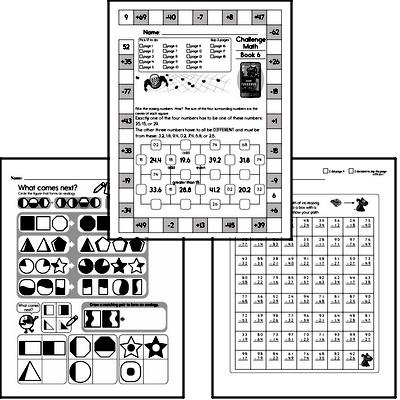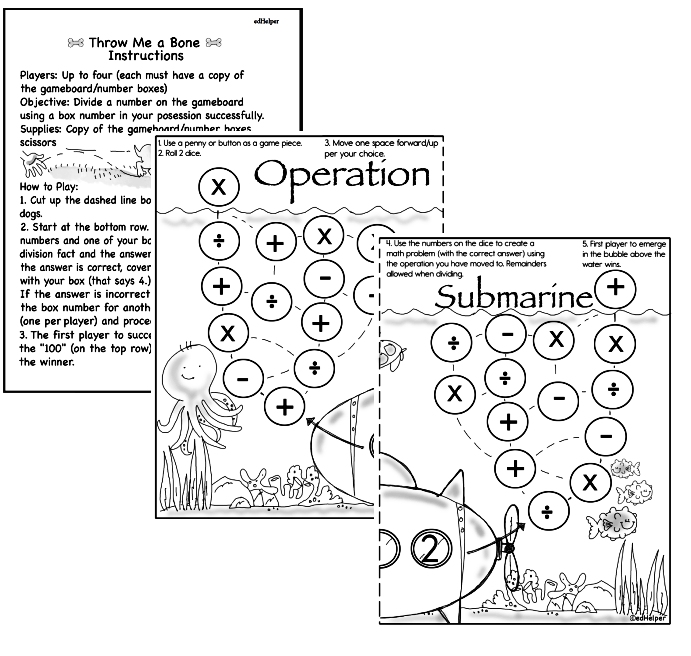Top Seven Simple and Creative Ways to Teach Math in Your Class that You Can Try Today
By: edHelper Staff
Updated: Oct 17, 2021
Teaching Math and Let Kids Play

Math has a bad reputation among kids. One bad experience with a mathematics unit can destroy children's confidence, making it difficult for them to tackle new units with excitement. Some kids may have internalized that they just aren't good at math, whether it's true or not, while other kids are great at math but are so bored that they can't seem to grasp new concepts!
As an educator, how can you reach these students while making sure you keep the ones who are interested engaged so that every child in the classroom has the opportunity to excel in math?
By finding creative ways to teach math in the classroom, of course! Here are a few of our favorite simple yet creative strategies for making math class a little more fun so that students will be open to learning whatever new math concept you throw their way.
Create a Routine With Fun Math Worksheets

There is some debate over whether or not math worksheets are effective. The trick is to use the right kind of worksheets at the right time.
For example, a math drill worksheet is only effective if the student completing the worksheet already understands how to do the math, while boring, blah worksheets covered in plain math problems are less likely to be completed as homework, and they will definitely never be what the students reach for if they are looking for an early finisher activity or fast finisher worksheets.
Instead, choose worksheets that students actually want to complete! EdHelper worksheets are specially created to engage students in meaningful math activities, but your students will have fun at the same time. You can download entire weekly workbooks designed to help students practice the skills they are currently learning in class. They feature fun games and activities that students will look forward to completing.
Another tip to make this strategy more effective is to create a routine that the kids can expect in your classroom. Pass out weekly workbooks that the students can work on throughout the week when they have downtime or as homework. This enables you to simplify handing out math work, and by choosing fun workbooks, the kids will enjoy working on the activities.
Try a sample of these weekly math activity workbooks:
1st Grade Weekly Math Workbook Freebie
2nd Grade Weekly Math Workbook Freebie
3rd Grade Weekly Math Workbook Freebie
4th Grade Weekly Math Workbook Freebie
5th Grade Weekly Math Workbook Freebie
6th Grade Weekly Math Workbook Freebie
Or print this week's math workbook, which is new and updated every week:
This Week's 1st Grade Math Activity Workbook
This Week's 2nd Grade Math Activity Workbook
This Week's 3rd Grade Math Activity Workbook
This Week's 4th Grade Math Activity Workbook
This Week's 5th Grade Math Activity Workbook
This Week's 6th Grade Math Activity Workbook
Pair Weekly Math With Online Math Games
Kids love technology. They are good at using technology, too! Integrating it into the classroom, you can get kids excited about practicing math and get easily-discouraged students to keep trying when they can use technology to practice.
EdHelper has designed math games for first through sixth grades that are customized based on the skills they are learning in the classroom. This ensures your students are practicing skills that they need to and are not just playing games because they are easy or mislearning new math concepts by playing games that are too hard. Kids can choose to practice math independently with these games, or they can challenge a parent or friend to play online.
The great thing about edHelper math games is that they can be paired with weekly math workbooks! Students can practice math the old-fashioned way with a pencil and paper and can practice the same skills online, too, providing them with double the exposure. Whether they are in the classroom or at home, you can keep track of your students' progress and assign math games and workbooks based on their abilities so that they always work on the right skills.
Hand Out Games That Students Can Play With Their Parents or Classmates

Download: Kindergarten Games to Hand Out and Let Students Play
Download: First to Second Grade Math Games to Hand Out
Download: Third to Fourth Grade Math Games to Hand Out
Student success rates soar with parental involvement. One popular way to do that is to host a math game night, but planning such a big event can feel overwhelming. Instead, teach your students how to play some math games in the classroom. Then, send them home to play the game with an adult.
Most students enjoy not only playing math games-especially when they can play them with their parents-but also having the opportunity to become the teacher. Get them excited about their new roles! Talk about how they will act when teaching their parents how to play the math game. You can even send home a note encouraging parents to sit quietly and ask questions to learn from their child rather than try to learn how to play by reading the directions.
Then, make the students hold their parents accountable by turning in their scores as homework. You could even incorporate a written component. Students could be required to write a short report on their experience acting as the teacher, how well their parents followed directions, and whether they think their parents need more practice.
Read Math Books

It's easy for math to exist only in math class, but the more you can integrate it into other subjects, the more likely you will engage all the kids in your classroom. For example, you may have a few students who love to read but hate math. Read math books, and you may be able to get them interested in math class!
Before you start a unit, read a math book about what the kids will learn from it. Then, during math class, leave the book out as an early finisher activity or make it part of the station rotation. You could read a new math book every week or ask older students to share a book or part of one that reminded them of math class.
This Week's Reading and Math Books for third to sixth graders:
3rd Grade Read and Do Math
4th Grade Read and Do Math
5th Grade Read and Do Math
6th Grade Read and Do Math
Sing Math Songs
Include music in math class, and you can reach even more students! If you have very young students, catchy singalongs are a great option. Check out some favorites and incorporate them into your curriculum whenever you address the concepts in the songs. It's even better if you can practice singing them while waiting in line or washing hands, as it's a great way to get students thinking about math even outside math class.
Catchy singalongs aren't likely to be very popular in a classroom of upper elementary kids. Fortunately, there are plenty of actual songs about math! You can find real-life musicians singing about math, both intentionally and unintentionally. Take time to explore some of these songs with your students, whether they are part of your current unit or not. The kids will love spending a portion of their math class listening to music, and you'll love the math conversations you'll have with your class when you listen to them together.
Use Toys as Manipulatives
Students always learn better when you make abstract concepts more relevant to their lives. One of our favorite ways to do that is to use toys as manipulatives!
For example, instead of using interlocking base ten cubes, use LEGO pieces. You can snap LEGO pieces onto a base plate to represent using ones to count to ten or how many tens are in 40. You can also use them to help kids practice visually adding numbers instead of adding them one by one on their fingers.
Are your students really into those pop fidget toys? Use them to create fun math activities! Want to get outside? Use bouncy balls to classify and chart which ones are the bounciest. With a little creativity, you can show kids that math is all around them, even when they play with their favorite toys.
Rotate Math Posters on the Wall
Math bulletin board posters are on the must-have list for most teachers. They can make your classroom more engaging, help you teach new math concepts, and provide students with a quick and easy reference while working independently. However, math posters also melt into the background, and before you know it, you and your students forget they are even there.
Instead of decorating your room at the beginning of the year with math posters and leaving them there, rotate the ones you have on the wall. It doesn't matter if you want to switch them every time you start a new unit, put up new ones after winter break, or only switch out one at a time every few weeks; when you replace the posters on the wall, your students are more likely to look at them, think about them, and use them as they complete their school work.
Math can be difficult for students, but teaching it can be difficult, too! Instead of standing up in front of the class to teach a new concept and passing out a boring worksheet for students to complete, get a little creative with one of the ideas on this list. Your students are sure to appreciate it, but you will also discover that teaching math can be a lot more fun when you're willing to think outside the box!















